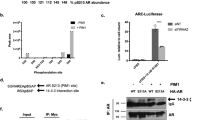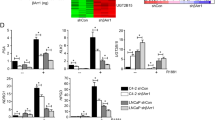Abstract
Prostate cancer (CaP) is initially androgen sensitive and responsive to hormone ablation therapy. However, cancer growth recurs despite androgen deprivation in the majority of cases of advanced disease. The molecular basis of this progression still remains unknown. The significance of androgen receptor (AR) coactivator proteins in this androgen-dependent malignancy is only beginning to emerge. In the present study, we examined the role of Tat interactive protein, 60 kDa (Tip60), an AR coactivator, in CaP progression. In hormone refractory CaP biopsies, we observed a nuclear accumulation of Tip60 expression in contrast to a more diffuse distribution pattern observed in benign prostate hyperplasia and primary CaP. Furthermore, in both the prostate xenograft model CWR22 and the LNCaP CaP cell line, we observed that androgen withdrawal promoted upregulation of Tip60 as well as nuclear accumulation. In contrast, androgen exposure resulted in decreased Tip60 expression that was more closely linked to a cytoplasmic presence. Chromatin immunoprecipitation analysis revealed Tip60's recruitment to the PSA gene promoter in both androgen-dependent and -independent cell lines. Thus, in vitro and in vivo data support a possible role for Tip60 in the molecular pathway leading to the development of androgen-independent CaP following long-term androgen deprivation therapy.
This is a preview of subscription content, access via your institution
Access options
Subscribe to this journal
Receive 50 print issues and online access
$259.00 per year
only $5.18 per issue
Buy this article
- Purchase on Springer Link
- Instant access to full article PDF
Prices may be subject to local taxes which are calculated during checkout







Similar content being viewed by others
Abbreviations
- AR:
-
androgen receptor
- CaP:
-
prostate cancer
- ChlP:
-
chromatin immunoprecipitation
- CWR22:
-
Case Western Reserve prostate xenograft strain 22
- RT–PCR:
-
reverse transcription polymerase chain reaction
- HR:
-
hormone refractory
- SDM:
-
steroid-depleted medium
- FM:
-
full medium
- CaS:
-
bicalutamide (Casodex)
- TURP:
-
transurethral resection of the prostate
- PSA:
-
prostate-specific antigen
- Tip60:
-
Tat interactive protein 60 kDa
- AI:
-
androgen independent
References
Brady ME, Ozanne DM, Gaughan L, Waite I, Cook S, Neal DE and Robson CN . (1999). J. Biol. Chem., 274, 17599–17604.
Brawer MK . (2000). Semin. Surg. Oncol., 18, 3–9.
Burkhart BA, Alcorta DA, Chiao C, Isaacs JS and Barrett JC . (1999). Exo. Cell. Res., 247, 168–175.
Caira F, Antonson P, Pelto-Huikko M, Treuter E and Gustafsson JA . (2000). J. Biol. Chem.. 275, 5308–5317.
Catalona WJ . (1994). N. Engl. J. Med, 331, 996–1004.
Chen SL, Wang SC, Hosking B and Muscat GE (2001). Mol. Endocrinol., 15, 783–796.
Cleutjens KB, van Eekelen CC, van der Korput HA, Brinkmann AO and Trapman J . (1996). J. Biol. Chem., 271, 6379–6388.
Crawford ED . (1992). Br. J. Urol., 70, 33–38.
Cutress RI, Townsend PA, Bateman AC, Johnson PW, Ryder K, Barnes DM and Packham G . (2001). J. Clin. Oncol., 19, 3706–3707.
Gao M, Ossowski L and Ferrari AC . (1999). J. Cell Physiol., 179, 336–346.
Gaughan L, Brady ME, Cook S, Neal DE and Robson, CN . (2001). J. Biol. Chem., 276, 46841–46848.
Gaughan L, Logan IR, Cook S, Neal DE and Robson, CN . (2002). J. Biol. Chem., 277, 25904–25913.
Gnanapragasam VJ, Robson CN, Neal DE and Leung HY . (2002). Oncogene, 21, 5069–5080.
Gregory CW, He B, Johnson RT, Ford OH, Mohler JL, French FS and Wilson EM . (2001). Cancer Res., 61, 4315–4319.
Horikawa I., Parker ES, Solomon GG and Barrett JC . (2001). J. Cell. Biochem., 82, 415–421.
Ikura, T., Ogrysko VV, Grigoriev M, Groisman R, Wang J, Horikoshi M, Scully R, Qin J and Nakatani Y . (2000). Cell, 102, 463–473.
Kinoshita H, Shi Y, Sandefur C, Meisner LF, Chang C, Choon A, Reznikoff CR, Bova GS, Friedl A and Jarrard DF . (2000). Cancer Res., 60, 3623–3630.
Koken MH, Reid A, Quignon F, Chelbi-Alix MK, Davies JM, Kabarowski JH, Zhu J, Dong S, Chen S, Chen Z, Tan CC, Licht J, Waxman S, de The H and Zelent A . (1997) Proc. Natl. Acad. Sci. USA., 94, 10255–10260.
Krenacs L, Harris CA, Raffeld M and Jaffe ES (1996) J. Cell. Pathol., 1, 125–136.
Kurebayashi J, Otsuki T, Kunisue H, Tanaka K, Yamamoto S and Sonoo H . (2000). Clin. Cancer. Res., 6, 512–518.
Kurihara I, Shibata H., Suzuki T., Ando T., Kobayashi S., Hayashi M., Saito I. and Saruta T . (2000). Endocr. Res., 26, 1033–1038.
Lee HJ, Chun M and Kandror KV . (2001). J. Biol. Chem., 276, 16597–16600.
Lee C, Sutkowski DM, Sensibar JA, Zelner D, Kim I, Amsel I, Shaw N, Prins GS and Kozlowski, JM . (1995) Endocrinology, 136, 796–803.
Majeed A, Babb P, Kones J and Quinn M . (2000). BJU Int., 85, 1058–1062.
McMahon SB, Van Buskirk HA, Drugan KA, Copeland TD and Cole MD . (1998) Cell, 94, 363–374.
Misiti S, Schomburg L, Yen PM and Chin WW . (1998) Endocrinology, 139, 2493–2500.
Muller JM, Isele U., Metzger E., Rempel A, Moser M, Pscherer A, Breyer T, Holubarsch C, Buettner R and Schule R . (2000). EMBO J., 19, 359–369.
Nagabhushan M, Miller CM, Pretlow TP, Giaconia JM, Edgehouse NL, Schwartz S, Kung HJ, de Vere White RW, Gumerlock PH, Resnick MI, Amini SB and Pretlow TG . (1996). Cancer Res., 56, 3042–3046.
Norton AJ, Jordan S and Yeomans P . (1994). J Pathol., 173, 371–379.
Ran Q and Pereira-Smith OM . (2000). Gene, 258, 141–146.
Reutens AT, Fu M, Wang C, Albanese C, McPhaul MJ, Sun Z, Balk SP, Janne OA, Palvimo JJ and Pestell RG . (2001). Mol. Endocrinol., 15, 797–811.
Shang Y, Myers M and Brown M . (2002). Mol. Cell., 9, 601–610.
Sheridan AM, Force T, Yoon HJ, O'Leary E, Choukroun G, Taheri MR and Bonvertre JV (2001). Mol. Cell. Biol., 21, 4470–4481.
Shi Y, Dones M, Xie W, Kao HY, Ordentlich P, Tsai CC, Hon M and Evans RM . (2001). Genes. Dev., 15, 1140–1151.
Sliva D., Zhu YX, Tsai S, Kamine J and Yang YC . (1999). Biochem. Biophys. Res. Commun., 263, 149–155.
Soto AM, Lin TM, Sakabe K, Olea N, Damassa DA and Sonnenschein C . (1995). Oncol. Res., 7, 545–558.
Spector DL . (1993). Curr. Opin. Cell. Biol., 5, 442–447.
Swinnen JV, Esquenet M, Heynes W, Rombauts W and Verhoeven G . (1994). Mol. Cell. Endocrinol. 104, 153–162.
Tekur S, Lau KM, Long J, Burnstein K and Ho SM . (2001). Mol. Carcinog., 30, 1–13.
Thenot S, Charpin M, Bonnet S and Cavailles V . (1999). Mol. Cell. Endocrinol., 156, 85–93.
Tsai MJ and O'Malley BW . (1994). Annu. Rev. Biochem., 63, 451–486.
Wainstein MA, He F, Robinson D, Kung HJ, Schwartz S, Giaconia JM and Edgehouse NL, Pretlow TP, Bodner DR and Kursh ED . (1994). Cancer Res., 54, 6049–6052.
Yamamoto T and Horikoshi M . (1997). J. Biol. Chem., 272, 30595–30598.
Yeh S and Chang C . (1996). Proc. Natl. Acad. Sci. USA., 93, 5517–5521.
Young CY, Andrews PE, Montgomery BT and Tindall DJ . (1992). Biochemistry, 31, 818–824.
Zeng C, Kim E, Warren SL and Berget SM . (1997). EMBO J., 16, 1401–1412.
Acknowledgements
We are grateful to Yoshihiro Nakatani for generously providing us with the Tip60 cDNA, and Trevor Booth (Electron Microscopy Unit, Newcastle Medical School) for helpful discussions and excellent technical assistance.
Author information
Authors and Affiliations
Corresponding author
Rights and permissions
About this article
Cite this article
Halkidou, K., Gnanapragasam, V., Mehta, P. et al. Expression of Tip60, an androgen receptor coactivator, and its role in prostate cancer development. Oncogene 22, 2466–2477 (2003). https://doi.org/10.1038/sj.onc.1206342
Received:
Revised:
Accepted:
Published:
Issue Date:
DOI: https://doi.org/10.1038/sj.onc.1206342
Keywords
This article is cited by
-
Loss of TIP60 (KAT5) abolishes H2AZ lysine 7 acetylation and causes p53, INK4A, and ARF-independent cell cycle arrest
Cell Death & Disease (2022)
-
Quantifying Tip60 (Kat5) stratifies breast cancer
Scientific Reports (2019)
-
Tip60: updates
Journal of Applied Genetics (2018)
-
ING3 promotes prostate cancer growth by activating the androgen receptor
BMC Medicine (2017)
-
Epigenetic modulators as therapeutic targets in prostate cancer
Clinical Epigenetics (2016)



